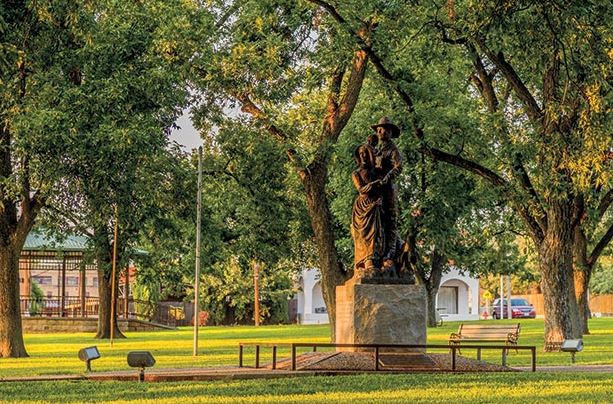(reprinted from Texas Highways article)
You get the idea of just how empty and remote the country around Ozona is when you learn that local officials installed a red light on top of the 1902 Crockett County Courthouse not only to summon the sheriff’s deputy but to guide travelers to town after dark.
Known these days primarily as a convenience stop between San Antonio and destinations out west, modern Ozona is often overlooked by visitors barreling through town on Interstate 10.
But don’t sell Ozona short. Just moments from the interstate, Ozona offers travelers a taste of West Texas past and present with an engaging history museum, downhome restaurants,
and friendly locals who appreciate the town’s slower pace of life.
Since 1938, visitors from all over the world have stopped at the Crockett County Courthouse square to take pictures with county namesake and Alamo hero David Crockett. Artist William M. McVey’s pink granite statue bears an inscription reflecting Crockett’s daring worldview: “Be sure you are right, then go ahead.”
“The best thing about Ozona is the quiet. And at night you can see the stars—every one of them.”
Just behind Crockett in the middle of the square, a bronze statue dubbed The Tie That Binds depicts a young pioneer family looking west—the woman in a bonnet, the man in full-brimmed hat and holding a boy. Created by Crockett County native Judy Black, the sculpture represents the hardships and community spirit of the pioneers who settled this isolated part of the world.
Ozona’s story continues across the street at the Crockett County Museum, where three stories of exhibits span from the Stone Age through the 1950s. Outdoors near the entrance, an early 20th-century wagon and water pump illustrate the challenges faced by settlers who spent most of their time and energy getting from place to place and finding water. With almost no surface water, Crockett County was uninha-bitable until the late 19th century, when the development of windmills and pumps allowed irrigation from the aquifer. The early settlers raised sheep and cattle, and the discovery of oil and gas in the 1920s made some of them millionaires.
The museum’s exhibits cover prehistoric fossils, Native American artifacts, and ranching tools, along with a few surprises. Among its exhibits chronicling the area’s ranching history, the museum highlights items that tell the story of female settlers, including elegant tea sets and delicate pieces of fine china from the early ranching days.
“The strong women of West Texas have a story that is often forgotten,” Museum Coordinator Emily Guerra says. “Our museum tells their story through the tea sets and china, along with a display of women’s hats and dresses from the early 20th century. It’s my favorite part of the museum.”
Next door to the museum is the stately 1902 Crockett County Courthouse. West Texas architect Oscar Ruffini designed the structure in the Second Empire style. Builders used locally quarried stone for the courthouse and also for the 1892 jail, parts of which are still in use. The jail resembles a church, although the belfry is really a hanging tower (the county never had to use it).
We are so honored to have someone see the charm in our town, we just had to share this article on our website.

